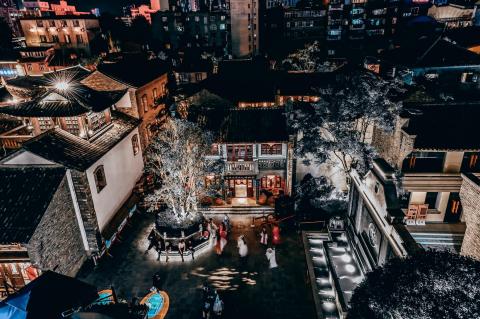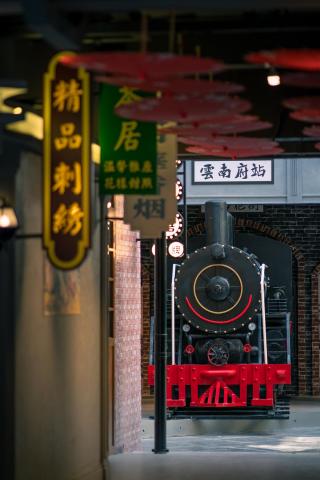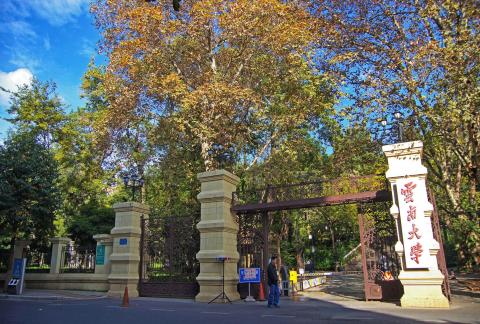Kunming Impression
Absorb city’s history with a walk around the old streets
If humankind is the soul of a city, then architecture is the body of a city. All the ancient constructions in Kunming form the context and heritage of this city. The buildings and old blocks represent the unique cultural coordinates, inheriting the personality and heritage and telling the history of Kunming.
Kunming Old Street

The Integration of the Frontier Minorities and Central Plains Culture
The Kunming Old Street area still retains a large number of historical buildings and cultural relics from the late Qing Dynasty and the Republic of China. The oldest one holds nearly 900 years of memories and stories of the city.
The old houses in Kunming Old Street are mainly composed of courtyard houses, while also combining the characteristics of folk houses of the Bai and Yi ethnic groups. These old houses represent the type of Kunming dwelling architecture during that period, exemplifying the integration of the Central Plains culture and Yunnan ethnic culture. They also represent the unique characteristics of Kunming that distinguish it from other cities.
Tongren Street
is the most typical example of Kunming French-style architecture. The arcade on Tongren Street merges the architectural styles of many European countries, coupled with the Chinese style, presenting an all-encompassing architectural scroll.
After the 1980s, Tongren Street gradually became commercial, with hair salons, photo galleries, dentists, fashion shops, as well as offering a variety of Hong Kong and foreign goods. At that time, Tongren Street, Jinbi Road, and Sanshi Street became the most prosperous "Golden Triangle" of Kunming City.
Tongren Street witnessed the combination of traditional Chinese architecture style and foreign cultures. It tells the historical story of Kunming in that era and also expresses the inclusive urban personality of Kunming City.
Chamahuajie Street

Chamahuajie, located on the west shore of Dianchi Lake, is a special place for Kunming culture and to enjoy a travel experience area in Xishan District. Chamahuajie is also the only way to the core scenic spot of Longmen, in Western Hill Forest Park.
Kunming was an important station on the ancient Tea-Horse Road and also home to a traditional flower market. In the old days, the horses carried the goods and tea just to catch up with the lively scene of Kunming flower market, which formed a grand scene of the transaction between the flower market and the tea market. This kind of scene was particularly prosperous during the Republic of China period and was later called "Chamahuajie."
Yunnan Zhenzhuang Guest House
The golden tile and red wall of No. 154 Beijing Road is incompatible with the surrounding modern environment. Entering Yunnan Zhenzhuang Guest House, the outside noise is separated by the wall. It is a unique garden area in the centre of the city.
In 1914, Germany chose this place to set up the German consulate in Yunnan. In 1936, the Yunnan Provincial Chairman Long Yun used it as his own residence. Since the founding of the country, it has become an important reception place for government affairs in Yunnan Province.
The architectural styles of Yunnan Zhenzhuang Guest House combine well with Chinese and Western styles. It has quiet and elegant courtyards and green bamboos.
Yunnan University

Every building in Yunnan University Donglu Campus has its own history. The oldest building here can even be traced back to 1499 AD.
Zhigongtang and Kaopeng are the heart of the Yunnan Gongyuan Building Group. It is one of the only testimonies of the history of China's 1,300-year imperial examination system in the country. The famous "Last Speech" by Mr. Wen Yiduo is here.
Completed in 1924, the Huize Academy designed by the Zhang Banghan is a landmark of Yunnan University Donglu Campus. This typical French-style building has experienced vicissitudes and recorded the development of Yunnan University. During the Anti-Japanese War, the Huize Academy became an important position for propaganda against Japan in China.
Kunming ancient Street and ancient buildings record the history of the city, giving a taste of the city.

